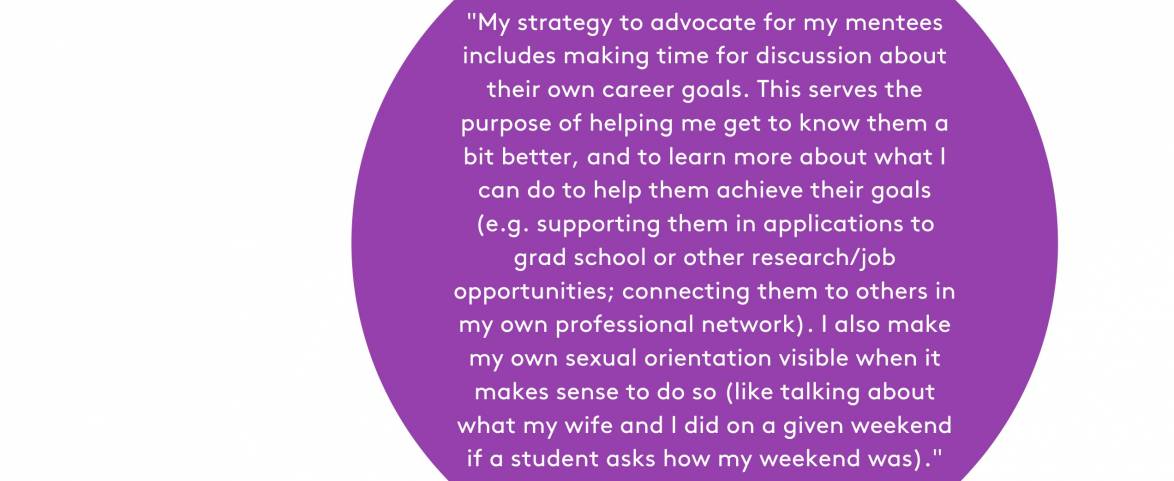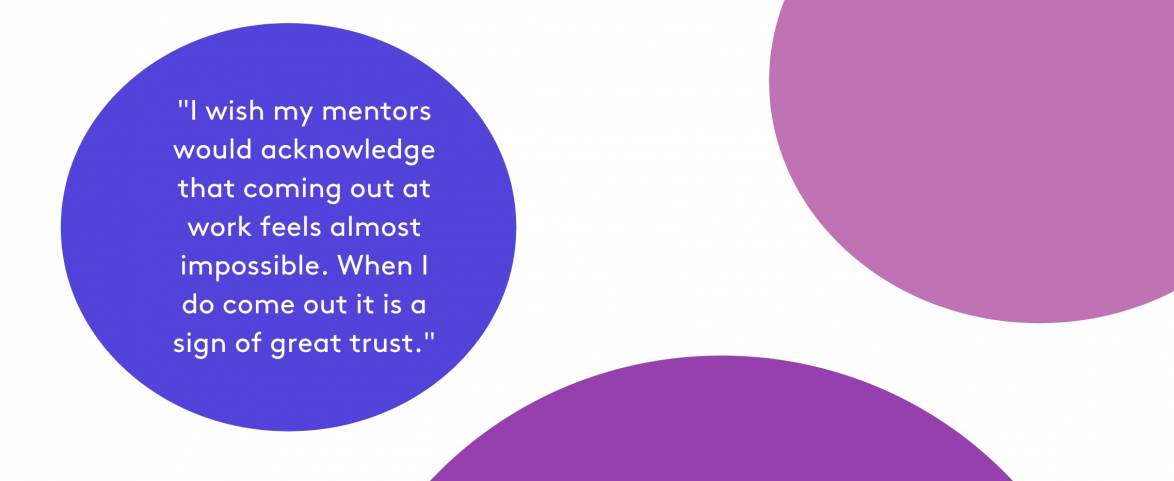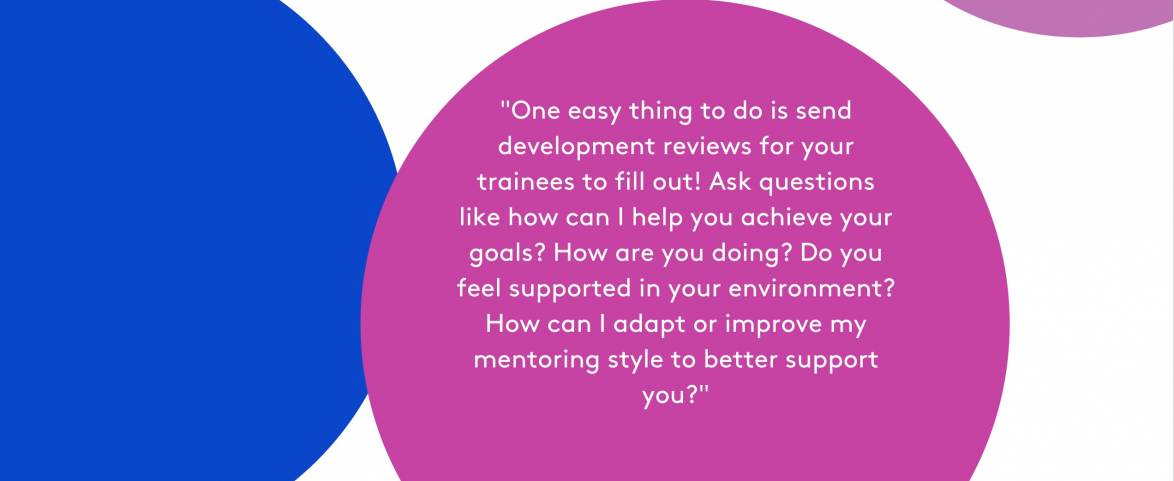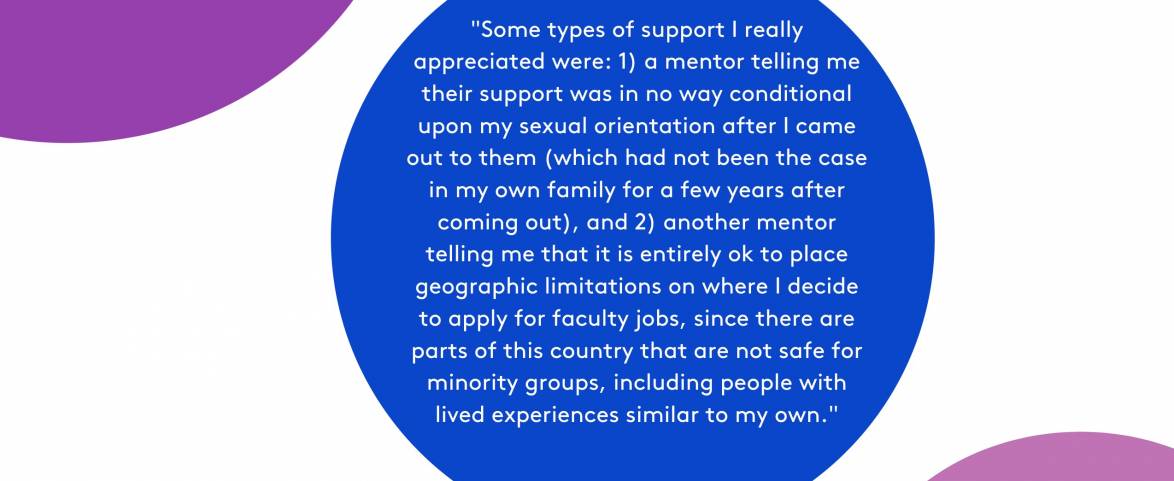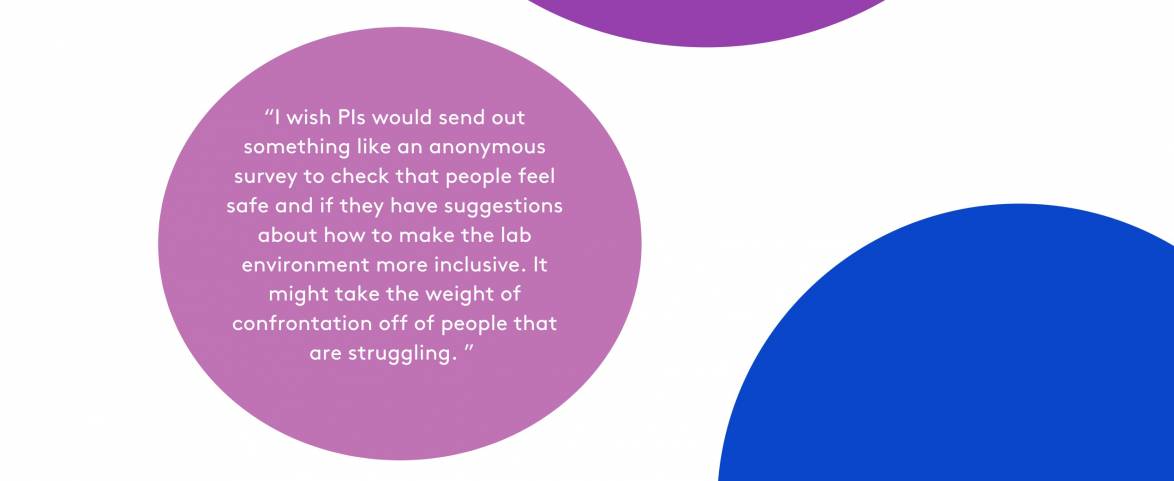Part 6: LGBTQIA+ Allyship Testimonials and Resources
In learning how to be an ally, we need to hear about and respect the lived experiences of other people. We provided an anonymous space for folks to share their allyship related experiences as mentees or mentors. Here is what they said…
Q1: Reflecting on your experience as a mentee, please describe a time when a mentor made you feel supported in your lived experience and/or advocated for you.
“Some types of support I really appreciated were:
1) a mentor telling me their support was in no way conditional upon my sexual orientation after I came out to them (which had not been the case in my own family for a few years after coming out), and
2) another mentor telling me that it is entirely ok to place geographic limitations on where I decide to apply for faculty jobs, since there are parts of this country that are not safe for minority groups, including people with lived experiences similar to my own.”
“One of my mentors was excellent at adjusting his mentorship style. I came out as non-binary after a year of working with him. It was helpful that he didn’t make a big deal out of it and that he didn’t out me to everyone at work. He asked how I wanted to be referred to, and adjusted rather quickly.”
Q2: What do you wish your mentor knew about how to support you?
“I wish my mentors knew that coming out at work can feel almost impossible. When I do come out it is a sign of great trust. For me, visibility is the most important thing. I want to see (not just hear about) my mentors making an effort toward being better allies.”
“You cannot assume that your trainees feel safe and included or that they will just figure out how to survive in their environment. A don’t ask, don’t tell attitude can be so harmful for your trainee’s mental health. I cannot do my job to the best of my ability if I am scared. ”
“I wish my mentors would send out something like an anonymous survey to see if people are feeling alright, if they feel safe, if they have suggestions about how to make the lab environment more inclusive. It might take the weight of confrontation off of people that are struggling. ”
Q3: In the context of allyship, what has been positive or negative about your experiences as a mentee?
“For me, a really positive change has been to see more people in my field (ecology & evolutionary biology), but also in many parts of this country, openly express their sexual and gender orientation. This makes me feel safer expressing my own identity in professional spaces, in contrast to how I felt growing up and through most of college.”
Q4: For mentors, are there specific strategies you have implemented to advocate for your trainees? Are there resources that you would like other mentors to know about?
“My strategy to advocate for my mentees includes making time for discussion about their own career goals. This serves the purpose of helping me get to know them a bit better, and to learn more about what I can do to help them achieve their goals (e.g. supporting them in applications to grad school or other research/job opportunities; connecting them to others in my own professional network). I also make my own sexual orientation visible when it makes sense to do so (like talking about what my wife and I did on a given weekend if a student asks how my weekend was).
“ I recently attended a mentorship training workshop through UWisconsin that I found very helpful. I also have started using mentoring network diagrams to help me and students think more about mentor/mentee roles and expectations (e.g. a single mentor cannot provide all the diverse forms of support that a mentee needs).”
Resources to share with your peers, trainees, and mentors!
Funding for minority students:
There are a number of funding opportunities for Hispanic, African American, Native American, disabled, and LGBTQIA+ students in STEM.
Resources:
- Lambda legal (nondiscrimination)
- LGBT National Help Center and Hotline – (888)-843-4564
- National Center for Transgender Equality
- The Safe Zone Project
- The National Association for the Advancement of Colored People
- American Civil Liberties Union (LGBTQ Rights)
- ASEE LGBTQIA+ Advocacy in STEM
Reading:
- Poirier, J. (2015). Improving conditions for learning for lesbian, gay, bisexual, transgender, and questioning (LGBTQ) students. Washington, DC: American Institutes for Research.
- Misawa, M. (2010). Queer Race Pedagogy for Educators in Higher Education: Dealing with Power Dynamics and Positionality of LGBTQ Students of Color. International Journal of Critical Pedagogy, 3 (1), 26-35. Retrieved from http://libjournal.uncg.edu/ijcp/article/view/68.
- A Decade of Research into the Workplace Environment for LGBTQ People (Human Rights Campaign)
- “A Few Pronoun Best [Preferred?] Practices” (It’s Pronounced Metrosexual)
- Jones, S. R. (2015). Intersectionality in Educational Research. J. L. Olive, D. J. Davis, & R. J. BrunnBevel (Eds.). Stylus Publishing, LLC.
- Kaijser, A., & Kronsell, A. (2014). Climate change through the lens of intersectionality. Environmental politics, 23(3), 417-433.
- Holvino, E. (2010). Intersections: The simultaneity of race, gender and class in organization studies. Gender, Work & Organization, 17(3), 248-277.
- Barres, B., Montague-Hellen, B., & Yoder, J. (2017). Coming out: the experience of LGBT+ people in STEM. Genome Biology, 18(1), 62.
- Bilimoria, D., & Stewart, A. J. (2009). Don’t ask, don’t tell: The academic climate for lesbian, gay, bisexual, and transgender faculty in science and engineering. National Women’s Studies Association Journal, 21(2), 85-103.
All content in the Guide to LGBTQIA+ Allyship for Mentors is shared under Creative Commons BY-NC 4.0. The whole guide is available for download as a PDF from the Save & Share menu.

